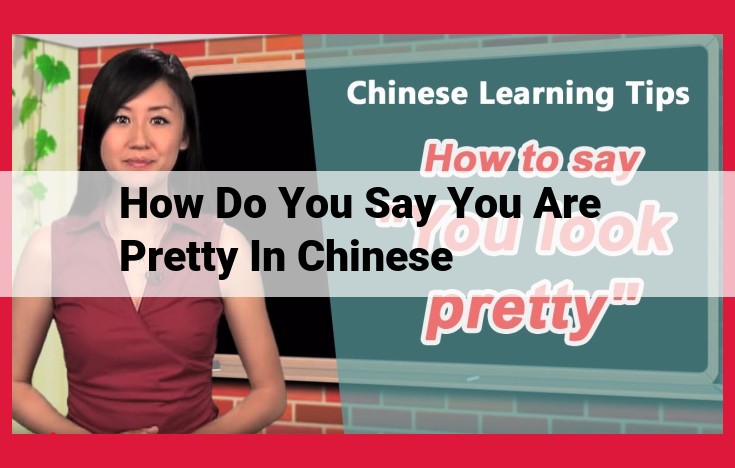In Chinese culture, beauty is often associated with a balanced and harmonious appearance, emphasizing symmetrical features, fair skin, and a slim figure. Common Chinese beauty terms include “piàoliang” (pretty), “měilì” (beautiful), and “jùnqiào” (elegant). When complimenting someone’s beauty, it is important to do so with sensitivity and avoid objectification. Appropriate compliments include “nǐ hěn piàoliang” (you are very pretty) and “nǐ hǎo měilì” (you are very beautiful).
Physical Appearance: The Ideal of Beauty
In societies around the globe, cultural norms and standards dictate the perception of beauty. Across time, these ideals have evolved and varied greatly, yet a common thread runs through many cultures: the pursuit of a balanced and harmonious appearance.
Symmetry and Proportion:
One cornerstone of the ideal of beauty is facial symmetry. Symmetrical features are often seen as a sign of health and genetic fitness, as they indicate a lack of developmental abnormalities. The “golden ratio,” or 1.618, is a mathematical proportion considered especially pleasing to the eye. When applied to the face, it creates a harmonious relationship between the various features, resulting in an attractive visage.
Fair Skin:
In many cultures, fair skin has long been associated with beauty. This preference can be traced back to historical factors, such as the association of pale skin with aristocracy and wealth. In societies where physical labor was the norm, fair skin was a sign of leisure and privilege. Today, while sun-kissed skin may be trendy in some circles, fair skin remains a sought-after aesthetic ideal in many parts of the world.
Slender Figure:
A slim and toned figure is often seen as a sign of beauty, particularly in Western societies. A lean frame is associated with health, vitality, and discipline. In recent decades, social media and the rise of fitness culture have further reinforced the idea that a slender body is an essential component of beauty.
It’s important to note that these cultural standards are not universal. Beauty ideals vary depending on factors such as race, ethnicity, and socioeconomic background. The key is to appreciate the diversity of beauty and to avoid perpetuating narrow and potentially harmful standards. Instead, we should celebrate the unique and diverse ways in which beauty manifests itself across cultures.
Beauty Standards in Chinese Culture: Exploring the Cultural Significance
Cultural Ideals of Beauty:
In Chinese culture, beauty is a highly valued and cherished concept. The traditional Chinese understanding of beauty stems from ancient philosophies that emphasize balance, harmony, and refinement. Throughout history, specific physical attributes have been held as ideals for both men and women.
Chinese Beauty Terminology:
To fully appreciate Chinese beauty standards, it’s crucial to understand key terms.
Piàoliang (漂亮):
- “Pretty” or “beautiful”
- Describes physical attractiveness, with an emphasis on a delicate and youthful appearance
Měilì (美丽):
- “Beautiful”
- Refers to a more refined and enduring beauty that encompasses both physical and inner qualities
Jùnqiào (俊俏):
- “Handsome” or “good-looking”
- Used to describe masculine beauty, characterized by sharp facial features and a tall, slender build
Cultural Significance:
These beauty terms carry significant cultural implications. Piàoliang represents the ephemeral beauty of youth, while měilì is associated with qualities that endure through time. Jùnqiào reflects the traditional Chinese ideal of a strong and charismatic man.
Respectful Compliments:
When complimenting someone’s beauty in Chinese, it’s essential to do so respectfully and avoid objectification. Common compliments include:
“Nǐ hěn piàoliang” (你好漂亮): “You are very pretty.”
“Nǐ hǎo měilì” (你好美丽): “You are very beautiful.”
“Nǐ hěn jùnqiào” (你好俊俏): “You are very handsome.”
By using these compliments appropriately, you not only show appreciation for someone’s beauty but also honor the cultural significance and values that underlie it.
Complimenting Beauty with Sensitivity in Chinese Culture
When it comes to expressing admiration for beauty in Chinese culture, it’s crucial to do so with respect and sensitivity. The Chinese language has a rich vocabulary for complimenting beauty, but using these phrases appropriately is essential.
Common Chinese Compliments for Beauty
- Nǐ hěn piàoliang (你很漂亮): This phrase translates to “You are very pretty” and is a common way to compliment someone’s overall appearance.
- Nǐ hǎo měilì (你好美丽): This phrase means “You are very beautiful” and is slightly more formal than piàoliang. It’s often used to compliment someone’s elegance or refinement.
Respectful Use of Compliments
While these compliments may seem innocuous, it’s important to avoid objectifying or reducing someone to their physical appearance. Instead, focus on expressing genuine appreciation for their beauty, personality, or other qualities.
For example, instead of simply saying “Nǐ hěn piàoliang,” you could say:
“You look absolutely radiant today. Your smile is so bright and your eyes sparkle with joy.”
This not only compliments their physical appearance but also acknowledges their positive energy and inner beauty.
Avoiding Objectification
It’s also crucial to avoid using compliments that could be perceived as objectifying. Phrases like “Nǐ de shēntǐ hěn hǎo” (你的身体很好, “Your body is great”) or “Nǐ de ròufú hěn měiguò (你的肉服很美过, “Your breasts are beautiful”) are inappropriate and can make someone feel uncomfortable.
Instead, focus on complimenting someone’s overall presence or qualities that transcend their physical appearance. By using compliments respectfully and avoiding objectification, you can create a positive and empowering atmosphere where beauty is appreciated in a healthy and respectful way.
